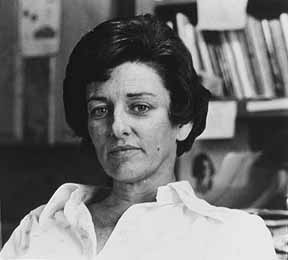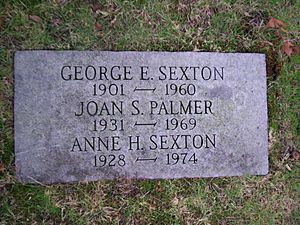Anne Sexton facts for kids
Quick facts for kids
Anne Sexton
|
|
|---|---|

Anne Sexton photographed by Elsa Dorfman
|
|
| Born | Anne Gray Harvey November 9, 1928 Newton, Massachusetts, United States |
| Died | October 4, 1974 (aged 45) Weston, Massachusetts, United States |
| Occupation | Poet |
| Nationality | American |
| Literary movement | Confessional poetry |
| Spouse | Alfred Muller Sexton II (1948–1973) |
| Children |
|
Anne Sexton (born Anne Gray Harvey; November 9, 1928 – October 4, 1974) was an American poet known for her highly personal, confessional verse. She won the Pulitzer Prize for poetry in 1967 for her book Live or Die. Her poetry details her long battle with bipolar disorder and intimate details from her private life, including relationships with her husband and children.
Early life and family
Anne Sexton was born Anne Gray Harvey in Newton, Massachusetts to Mary Gray (Staples) Harvey (1901–1959) and Ralph Churchill Harvey (1900–1959). She had two older sisters, Jane Elizabeth (Harvey) Jealous (1923–1983) and Blanche Dingley (Harvey) Taylor (1925–2011). She spent most of her childhood in Boston. In 1945 she enrolled at Rogers Hall boarding school in Lowell, Massachusetts, later spending a year at Garland School. For a time she modeled for Boston's Hart Agency. On August 16, 1948, she married Alfred Muller Sexton II and they remained together until 1973. Sexton had her first child, Linda Gray Sexton, in 1953. Her second child, Joyce Ladd Sexton, was born two years later.
Poetry
Sexton suffered from severe bipolar disorder for much of her life, her first manic episode taking place in 1954. After a second episode in 1955 she met Dr. Martin Orne, who became her long-term therapist at the Glenside Hospital. It was Orne who encouraged her to write poetry.
The first poetry workshop she attended was led by John Holmes. Sexton felt great trepidation about registering for the class, asking a friend to make the phone call and accompany her to the first session. She found early acclaim with her poems; a number were accepted by The New Yorker, Harper's Magazine and the Saturday Review. Sexton later studied with Robert Lowell at Boston University alongside poets Sylvia Plath and George Starbuck. Sexton later paid homage to her friendship with Plath in the 1963 poem "Sylvia's Death". Her first volume of poetry, To Bedlam and Part Way Back, was published in 1960, and included the poem "Her Kind", which uses the persecution of witches as an analogy for the oppression of women in a patriarchal society.
Sexton's poetic career was encouraged by her mentor W. D. Snodgrass, whom she met at the Antioch Writer's Conference in 1957. His poem "Heart's Needle" proved inspirational for her in its theme of separation from his three-year-old daughter. Sexton first read the poem at a time when her own young daughter was living with her mother-in-law. She, in turn, wrote "The Double Image", a poem which explores the multi-generational relationship between mother and daughter. Sexton began writing letters to Snodgrass and they became friends.
While working with John Holmes, Sexton encountered Maxine Kumin. They became good friends and remained so for the rest of Sexton's life. Kumin and Sexton rigorously critiqued each other's work and wrote four children's books together. In the late 1960s, the manic elements of Sexton's illness began to affect her career, though she still wrote and published work and gave readings of her poetry. She collaborated with musicians, forming a jazz-rock group called Her Kind that added music to her poetry. Her play Mercy Street, starring Marian Seldes, was produced in 1969 after several years of revisions. Sexton also collaborated with the artist Barbara Swan, who illustrated several of her books.
Within 12 years of writing her first sonnet, she was among the most honored poets in the U.S.: a Pulitzer Prize winner, a fellow of the Royal Society of Literature and the first female member of the Harvard chapter of Phi Beta Kappa.
Death
On October 4, 1974, Sexton had lunch with Kumin to revise galleys for Sexton's manuscript of The Awful Rowing Toward God, scheduled for publication in March 1975 (Middlebrook 396). On returning home she put on her mother's old fur coat, removed all her rings, poured herself a glass of vodka, locked herself in her garage, and started the engine of her car, ending her life by carbon monoxide poisoning.
In an interview over a year before her death, she explained she had written the first drafts of The Awful Rowing Toward God in 20 days with "two days out for despair and three days out in a mental hospital." She went on to say that she would not allow the poems to be published before her death. She is buried at Forest Hills Cemetery & Crematory in Jamaica Plain, Boston, Massachusetts.
Content and themes of work
Sexton is seen as the modern model of the confessional poet due to the intimate and emotional content of her poetry. Sexton often wrote and disclosed her struggles with mental illness through her work. Sexton was heavily criticized for her poetic content and themes.
Her eighth collection of poetry is entitled The Awful Rowing Toward God. The title came from her meeting with a Roman Catholic priest who, unwilling to administer last rites, told her "God is in your typewriter." This gave the poet the desire and willpower to continue living and writing. The Awful Rowing Toward God and The Death Notebooks are among her final works, and both center on the theme of dying.
Her work started out as being about herself, however as her career progressed she made periodic attempts to reach outside the realm of her own life for poetic themes. Transformations (1971), which is a re-visionary re-telling of Grimm's Fairy Tales, is one such book. (Transformations was used as the libretto for the 1973 opera of the same name by American composer Conrad Susa.) Later she used Christopher Smart's Jubilate Agno and the Bible as the basis for some of her work.
Much has been made of the tangled threads of her writing, her life and her depression. Robert Lowell, Adrienne Rich and Denise Levertov commented in separate obituaries on the role of creativity in Sexton's death. Levertov says, "We who are alive must make clear, as she could not, the distinction between creativity and self-destruction."
Legacy
Peter Gabriel dedicated his song "Mercy Street" (named for her play Mercy Street and inspired by his reading of her poem "45 Mercy Street") from his 1986 album, So, to Sexton. She has been described as a "personal touchstone" for Morrissey, former lead singer and lyricist of The Smiths. She is commemorated on the Boston Women's Heritage Trail. She has also been cited as muse for Madonna, who has talked about her in interviews over the years.
See also
 In Spanish: Anne Sexton para niños
In Spanish: Anne Sexton para niños


